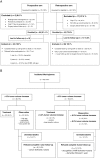A prospective study of the natural history of incidental meningioma-Hold your horses!
- PMID: 31832214
- PMCID: PMC6899048
- DOI: 10.1093/nop/npz011
A prospective study of the natural history of incidental meningioma-Hold your horses!
Abstract
Background: The number of incidental meningiomas has increased because of the increased availability of neuroimaging. Lack of prospective data on the natural history makes the optimal management unclear. We conducted a 5-year prospective study of incidental meningiomas to identify risk factors for tumor growth.
Methods: Sixty-four of 70 consecutive patients with incidental meningioma were included. Clinical and radiological status was obtained at 0, 0.5, 1, 1.5, 2, 3, 4, and 5 years. GammaPlan and mixed linear regression modeling were utilized for volumetric analysis with primary endpoint tumor growth.
Results: None of the patients developed tumor-related symptoms during the study period, although 48 (75%) tumors increased (>15%), 13 (20.3%) remained unchanged, and 3 (4.7%) decreased (>15%) in volume. Mean time to growth was 2.2 years (range, 0.5-5.0 years).The growth pattern was quasi-exponential in 26%, linear in 17%, sigmoidal in 35%, parabolic in 17%, and continuous reduction in 5%. There was significant correlation among growth rate, larger baseline tumor volume (P < .001), and age in years (<55 y: 0.10 cm3/y, 55-75 y: 0.24 cm3/y, and >75 y: 0.85 cm3/y).
Conclusion: The majority of meningiomas will eventually grow. However, more than 60% display a self-limiting growth pattern. Our study provides level-2 evidence that asymptomatic tumors can be safely managed utilizing serial imaging until persistent radiological and/or symptomatic growth.
Keywords: asymptomatic meningioma; incidental meningioma; natural history; prospective study; volumetric tumor growth.
© The Author(s) 2019. Published by Oxford University Press on behalf of the Society for Neuro-Oncology and the European Association of Neuro-Oncology. All rights reserved. For permissions, please e-mail: journals.permissions@oup.com.
Figures


References
-
- Mawrin C, Chung C, Preusser M. Biology and clinical management challenges in meningioma. Am Soc Clin Oncol Educ Book. 2015:e106–e 115. - PubMed
-
- Vernooij MW, Ikram MA, Tanghe HL, et al. . Incidental findings on brain MRI in the general population. N Engl J Med. 2007;357(18):1821–1828. - PubMed
-
- Nakasu S, Hirano A, Shimura T, Llena JF.. Incidental meningiomas in autopsy study. Surg Neurol. 1987;27(4):319–322. - PubMed
LinkOut - more resources
Full Text Sources
Medical

